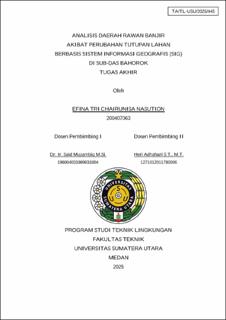| dc.description.abstract | This study was conducted in the Bahorok Sub-watershed, Bahorok District, Langkat Regency, to analyze land cover changes and their impact on flood vulnerability in 2014, 2018, and 2023. Land cover data were obtained from Landsat 8 (2014) and Sentinel-2 (2018 and 2023) imagery, processed using Google Earth Engine(GEE) and Geographic Information Systems (GIS). The analysis parameters included land cover, slope, rainfall, elevation, and soil type, while peak flood discharge was calculated using the Nakayasu Unit Hydrograph (HSS Nakayasu) method. The results showed a decline in vegetation cover from 243.579 km² in 2014 to 235.993 km² in 2023, while built-up areas increased from 0.178 km² to 3.192 km², causing a rise in peak flood discharge for a 2-year return period from 203.10479 m³/s to 209.6302 m³/s. Spatial analysis revealed that the areas with the highest flood vulnerability included Timbang Lawan and Timbang Jaya Villages, which experienced significant expansion in high flood-risk zones during the study period. This study recommends vegetation rehabilitation, land conservation through terracing techniques in steep areas to prevent erosion, and spatial planning that incorporates flood risk considerations. Furthermore, efforts to enhance community capacity in disaster mitigation and sustainable environmental management are crucial to minimize the impact of land cover changes on flood vulnerability in the Bahorok Sub-watershed. | en_US |


